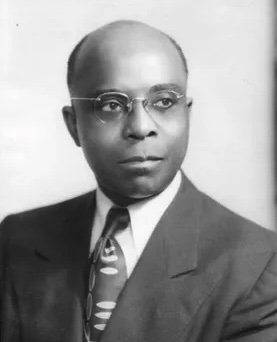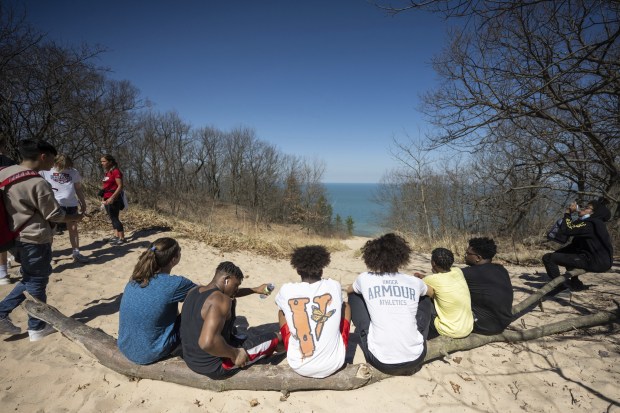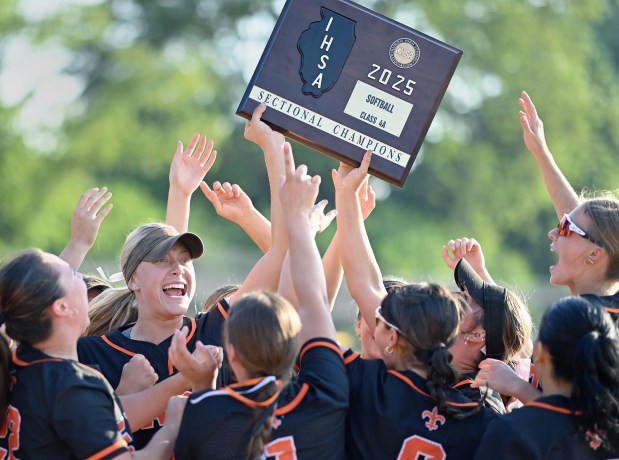A Roosevelt High School principal leading a group of his teachers won a showdown with the park superintendent at the front gate of the Indiana Dunes State Park on June 9, 1934, which became a key Civil Rights historical moment involving public beach access in Northwest Indiana.
The little-known episode was highlighted in a paper titled Lines in the Sand: Segregation and Recreation of Public Beaches on the Indiana Lakefront written by Simeon Klepac, a Valparaiso University student.
Serena Ard, museum curator at the Westchester Public Library, helped Klepac with his research. A Facebook post on the Friends of Indiana Dunes, Inc. site recently lauded Klepac’s work.
“There hasn’t really been much focus on segregated beaches and public beaches in Porter County and LaPorte County,” Ard said.
Klepac said it was during his internship as a ranger at the Indiana Dunes National Park that he researched the Civil Rights history concerning beach and park access. He said he found the story “complex” because there was a variance in how situations were handled. He was also surprised about the details he found when he reviewed the correspondence of state officials concerning the June 9, 1934, incident.
Racial conflict was common in Northwest Indiana and there were active KKK members in the first half of the 20th Century. Chesterton, located three miles south of the beach, and Valparaiso were known as “sundown” towns, meaning that Blacks weren’t welcome after nightfall. Ard said several articles from the Chesterton Tribune reflect the hostile attitude, including one from the 1920s praising the fact that a Black family was driven from their Liberty Township farmland.
Those familiar with the history of desegregation of public beaches along Northwest Indiana’s Lake Michigan shoreline know about the struggles at Marquette Park in Gary during the late 1940s and early 1950s. A group called “Beachhead for Democracy” that protested the policy of prohibiting Blacks at Marquette Beach, was pelted with rocks on Aug. 22, 1949, as police were called to quell the situation. It wasn’t until 1953 that the beach was finally open to Blacks.
Nearly two decades before on June 9, 1934, H. Theodore Tatum, the principal and a group of teachers from his Roosevelt High School in Gary, just wanted to have a picnic at the Indiana Dunes State Park. They instead had an encounter with then-Park Superintendent John S. Fishback at the iconic front entrance of the Indiana Dunes State Park.
Snow is seen along the beach as people watch the sun set from Indiana Dunes State Park in Chesterton, Indiana. A principal at Gary’s Roosevelt High School was instrumental in desegregating the beach in 1934. (Armando L. Sanchez/Chicago Tribune)
The park had opened in 1926 and soon became the state’s most popular park and a Midwest attraction. Klepac said that Indiana Dunes State Park then actually offered the most trouble-free public beach access to Blacks in Northwest Indiana.
But the rules suddenly changed when Fishback started as the superintendent at the Indiana Dunes State Park Beach in early 1934. Fishback instructed his employees that Blacks were to be directed to Tremont Road, which had inferior parking facilities and a long walk to a section of the beach far from the pavilion and prime picnic locations.
Klepac said that Tatum and the teachers weren’t expecting conflict because they were unaware of the new policy.
Tatum had just completed his first year as principal in what would be a 28-year career at Roosevelt High School, an all-Black institution. In the 1920s, the school district sent 18 Black students to all-white Emerson High School and white students staged a series of protests and walk-outs. City, school and NAACP leaders decided to build a school for Blacks, prompting the establishment of Roosevelt.
Tatum — who died at age 89 in 1983 — made a “big impact” on the community through his leadership of the historic school during its prime years, said Pastor Jerry Protho of the Unity Baptist Church in Gary, who is a 1966 graduate.
“He demanded respect,” said Protho, whose older siblings had Tatum as their principal at Roosevelt.

When Tatum arrived, he found that the front gate attendant was attempting to keep Black teachers from the front entrance leading to the new roadway and pavilion. Instead, the Black teachers were advised to drive the long way to enter at the east side of the park.
Tatum was having none of it as he took charge and advised the attendant: “You had better get the superintendent, otherwise we are going in the park.”
Fishback asked Tatum why he wouldn’t go to the east entrance. Tatum in turn asked whether Fishback’s policy of segregation came from the state administration.
When Fishback didn’t answer, Tatum handed money to the attendant and drove through. The other teachers followed suit, even after Fishback ordered the attendant to stop accepting the money from the Blacks.

Fegely Middle School eighth-graders rest on a log and take in the view after tackling the second of three dunes in the 3 Dune Challenge during a field trip to the Indiana Dunes State Park on Wednesday, April 12, 2023. A principal at Gary’s Roosevelt High School was instrumental in desegregating the beach in 1934. (Kyle Telechan for the Post-Tribune)
Fishback even climbed onto the running board of one of the vehicles, ordering the group to stop but it was to no avail, according to one news account in the Gary American, a newspaper serving the Black community.
Tatum and his teachers were able to have their picnic that day.
But there was more work to be done to solidify the gains from a one-day victory at the front gate.
In news accounts, Fishback complained that the Roosevelt principal and teachers were “obstinate” and had nearly run him over. He stated that his reasoning for having Blacks enter off Tremont Road was to keep the peace.
Some rowdy young white Chicago residents frequented the Indiana Dunes State Park Beach, and Fishback feared that there would be disruptions if Blacks were permitted to mix with them.
During the summer of 1919 in Chicago, days of deadly riots were triggered after a Black teenager was killed because he happened to be in an area designated for whites at 29th Street Beach on the South Side.
Tatum wrote a letter to Indiana Governor Paul V. McNutt, complaining about Fishback’s “unjust and discriminatory actions” and noted that “there is no law in Indiana which prohibits any citizen from using a state park.”
“All we ask is the use of the improved picnic grounds. We don’t request the use of bathhouses, and we are willing to bathe to the east of the regular beach,” Tatum told The Post-Tribune.
Tatum’s letter and statements to reporters reveal that his priorities were not for full equal treatment but equal access to public accommodations, Klepac’s paper concludes. It also shows that he realized the racial volatility of the times. Klepac states that from his research, it also seemed to him that Tatum — a well-educated man — was annoyed that he had to deal with the situation.
Governor McNutt replied that the matter would be resolved, and he delegated the matter to two men who oversaw the Indiana State Park system.
A resolution was needed because the National Alliance of Postal Workers, a largely Black association of mailmen from Chicago and Gary, feared that plans for a July 4 picnic involving hundreds of their members at the Indiana Dunes State Park would be ruined by Fishback’s policy.
Percy Hines, secretary-treasurer for the National Alliance of Postal Workers in Chicago, wrote a letter to Fishback, noting that Blacks are “American citizens and under the Constitution of the United States are entitled to equality under the law. They pay taxes which help to augment appropriations for the upkeep of Dunes Park and are justly due full use of the facilities as are the members of any racial group.”
Edward Gaskin, who was president of the National Alliance of Postal Workers in Gary, appealed to state officials — including a copy of the letter to the governor — clearly stating their desire to have full access to the beach and that they not be shunted off to a secluded area.
The settlement reached was that Black visitors had access to the main entrance, parking, picnic facilities and the bathhouse, but would not swim in the same area as whites in Lake Michigan.
The July 4 picnic was a success as about 1,000 National Alliance of Postal Workers attended with no incidents.
In the days afterward, there were Blacks who visited the beach to test if the state would keep its word. The policy became permanent at the Indiana Dunes State Park and Black attendance grew in subsequent years. The park even hired its first Black employee.
About five years later in Michigan City, the public access issue for Blacks at Washington Park came to a head after the tragic drowning of 12-year-old Cornelius Aiken on Aug. 2, 1939.
In Michigan City, Blacks were prohibited in Washington Park and relegated to a beachfront west of the park.
There were no lifeguards where Aiken was swimming, and he became caught in a rip current. It took 20 minutes for rescue personnel to respond.
“For Cornelius Aiken, it was not the current of the Lake Michigan riptide but the racial boundaries around recreational space that proved the deadlier,” said Charles Wise in his memoir, “From Oak Hill to the Patch,” which Klepac cites in his paper.
The Black community mobilized, led by Russel and Blenda Allen, and protested to the Michigan City administration.
In response, the city administration didn’t formally change its policy but Blacks began going anyway to Washington Park Beach in 1940.
A swimming area in Lake Michigan for Blacks only was roped off. It wasn’t until after World War II in 1947 that the ropes finally disappeared.
In his conclusion, Klepac notes that the situations where city administrations were in control of beach access — Gary and Michigan City — differed from the Indiana Dunes State Park and were slower to respond to change.
“While racist social pressures were persistent, Black Civil Rights leaders worked within these limits to effectively expand fair access through their challenges to segregationist policy,” Klepac wrote.
Jim Woods is a freelance reporter for the Post-Tribune.





